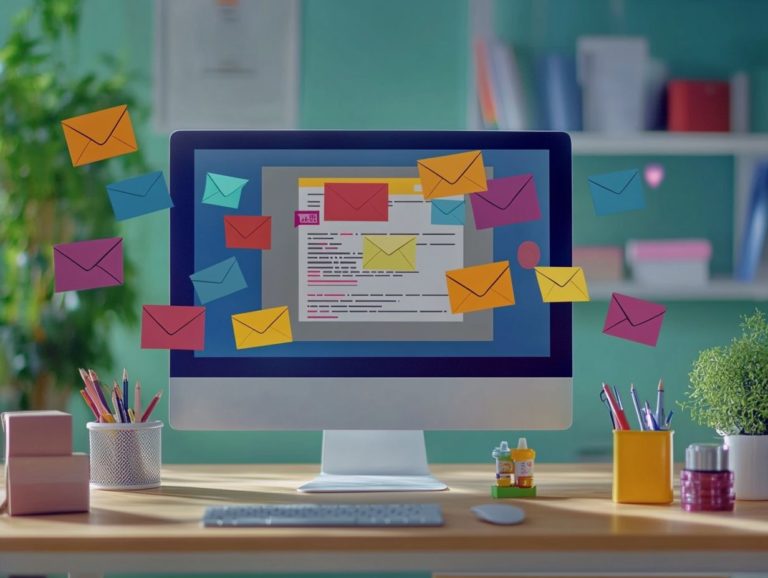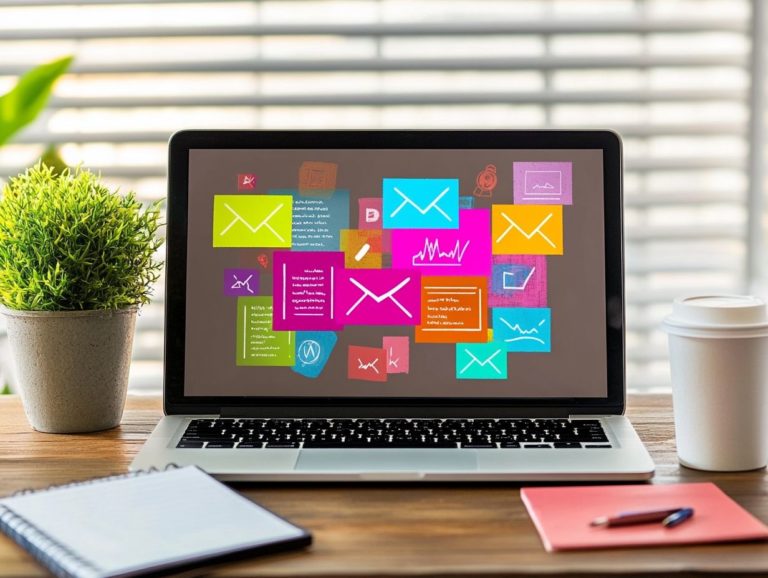The Power of Segmentation in Email Marketing
Let's Set Up Your Lead Generation Strategy
Fill out the form below, and our team will get in touch with you to create a tailored solution for your business.
Email marketing is a powerful tool. Its effectiveness relies heavily on one key strategy: segmentation.
Segmenting your email list into targeted groups allows you to customize your messaging. This alignment with your audience’s needs and preferences is crucial.
This article explores why email marketing segmentation matters. We will look at demographic, behavioral, and segmentation based on interests and lifestyles, along with the benefits it brings.
Get ready to discover practical tools and best practices to enhance your segmentation efforts! Unlock the full potential of your email campaigns!
Contents
- Key Takeaways:
- The Importance of Email Marketing Segmentation
- Types of Email Segmentation
- Let's Set Up Your Lead Generation Strategy
- Benefits of Email Segmentation
- How to Segment Your Email List
- Best Practices for Email Marketing Segmentation
- Let's Set Up Your Lead Generation Strategy
- Frequently Asked Questions
- Let's Set Up Your Lead Generation Strategy
Key Takeaways:

- Segmenting your email list is crucial for successful campaigns.
- Types of segmentation, like demographic and behavioral, allow for personalized communication.
- Effective segmentation can lead to higher engagement and conversions.
The Importance of Email Marketing Segmentation
Email marketing segmentation customizes your communications based on customer behavior and preferences. This targeted content resonates with specific groups, leading to higher engagement.
Personalization enhances customer satisfaction and fosters long-term loyalty. It also drives the rate at which emails lead to sales throughout the sales cycle.
Why Segmenting Your Email List is Essential
Segmenting your email list maximizes engagement rates. It ensures your tailored content reaches the right audience at the right time.
By dividing recipients based on criteria like purchasing behavior or demographics, you can send highly relevant messages. This approach boosts your emails’ chances of landing in inboxes rather than spam folders.
Tailored offers increase the likelihood of engagement. Understanding customer nuances allows for better alignment of promotional offers to drive conversions.
Types of Email Segmentation
Email segmentation can take various forms: demographic, behavioral, and segmentation based on interests and lifestyles. Tailoring your emails to specific segments makes your communication more effective.
Demographic, Behavioral, and Segmentation Based on Interests and Lifestyles

Demographic segmentation focuses on factors like age, gender, and location. Behavioral and psychographic segmentation look at user actions and interests, allowing for targeted campaigns.
Understanding demographics helps create detailed audience profiles. Different age groups may respond uniquely to messaging, while location influences purchasing behavior.
Behavioral insights reveal customer interactions, uncovering usage patterns. Psychographic factors explore motivations and lifestyles, making your campaigns even more relevant.
Let's Set Up Your Lead Generation Strategy
Fill out the form below, and our team will get in touch with you to create a tailored solution for your business.
This strategic approach empowers your business to enhance engagement and conversion rates. Transform data into actionable strategies that resonate with your audience!
Benefits of Email Segmentation
Implementing email segmentation offers a wealth of benefits that can transform your marketing strategy. By tailoring your messages to specific audience segments, you can significantly enhance engagement rates, boost conversion rates, and foster stronger customer loyalty.
These elements are crucial for achieving lasting success in today s competitive landscape.
Increased Engagement and Conversions
Increased engagement and conversions stand out as two of the most impactful advantages of email segmentation. When you deliver targeted content, you naturally elevate email activity and foster positive interactions with customers.
This personalized approach ensures that your recipients receive content that truly aligns with their unique interests, leading to improved open rates and click-through rates.
For example, a well-known e-commerce brand effectively segmented its email list based on past purchase behavior. This strategy allowed them to send out personalized product recommendations that resulted in a significant boost in sales during holiday promotions.
A travel agency also targeted previous customers with tailored travel packages reflecting their past destinations. This effort remarkably improved re-engagement rates.
By tapping into insights from customer behavior, you can build stronger connections, ultimately driving conversions and nurturing brand loyalty.
How to Segment Your Email List
To successfully segment your email list, you ll need to employ effective tools and strategies. This includes leveraging the advanced features provided by your email service provider, as well as gathering useful information from subscriber preferences and behavioral data.
Tools and Strategies for Effective Segmentation

You have a wealth of tools and strategies at your disposal for effective email segmentation, enabling you to analyze engagement metrics and optimize your interactions with customers.
By utilizing popular email segmentation tools, you can significantly enhance your ability to target audiences with tailored content. Platforms like Mailchimp, HubSpot, and Klaviyo provide features such as demographic targeting, behavioral tracking (tracking how customers interact with your emails), and performance analytics.
These tools give you the power to get useful information into customer behaviors, allowing for segmentation based on interaction history, preferences, and purchasing patterns.
With the implementation of real-time analytics, you can adjust your strategies dynamically. This ensures that the right message reaches the right audience at the perfect moment. This level of personalization not only elevates engagement rates but also cultivates long-term customer loyalty.
Best Practices for Email Marketing Segmentation
Implementing best practices for email marketing segmentation requires a deep understanding of your subscribers’ preferences. Create content that speaks to your audience and grabs their attention. Design promotional offers and re-engagement campaigns that are not only effective but also captivating.
Let's Set Up Your Lead Generation Strategy
Fill out the form below, and our team will get in touch with you to create a tailored solution for your business.
By honing in on these elements, you can elevate your email marketing strategy to new heights.
Tips for Maximizing Results
To truly maximize the results of your email segmentation efforts, prioritize optimizing customer satisfaction through relevant email interactions and targeted marketing campaigns. This strategy not only boosts engagement but also cultivates long-term loyalty among your subscribers.
Consider incorporating A/B testing (comparing two versions to see which one works better) for subject lines to discover what resonates best with various segments of your audience. Keep a keen eye on engagement metrics like open rates and click-through rates; these insights are invaluable for grasping subscriber preferences.
Regularly refine your marketing campaigns based on direct customer feedback, as their interactions can provide a clearer picture of what sparks interest. By continually adapting your strategies, you can significantly enhance the effectiveness of your segmentation, leading to more successful outcomes overall.
Frequently Asked Questions
Coming soon: answers to your most pressing questions about email segmentation!
Start segmenting your email lists today for better marketing results!
What is segmentation in email marketing?

Segmentation in email marketing means splitting an email list into smaller groups. These groups are based on specific traits like age, interests, or behaviors.
This practice helps create personalized and targeted email campaigns.
Why is segmentation important in email marketing?
Segmentation is crucial because it enables effective communication with your subscribers. Tailoring content to specific groups increases engagement, conversions, and your overall return on investment.
How can segmentation improve my email marketing results?
Segmentation boosts email marketing results by sending more personalized and relevant content. This leads to higher open rates, click-through rates, and conversions.
It also reduces the risk of sending irrelevant emails, which can cause unsubscribes and hurt your reputation as a sender.
What are some common segmentation strategies used in email marketing?
Common segmentation strategies include dividing your list by age, gender, and location. You can also segment based on interests, such as website activity or past purchases.
Additionally, you can group subscribers based on their engagement levels, like active versus inactive, or by their buying behavior.
How do I collect the data needed for effective segmentation?
You can gather data using surveys, website analytics, and email click data. Focus on collecting valuable information like purchase history and subscriber preferences.
Let's Set Up Your Lead Generation Strategy
Fill out the form below, and our team will get in touch with you to create a tailored solution for your business.
Can I use segmentation for all types of email marketing campaigns?
Absolutely! You can apply segmentation to promotional offers, newsletters, and transactional emails. Tailoring your messaging to each audience segment improves subscriber engagement and meets your campaign goals.






